Øyvind Kvålsvoll 20.08.2015 Download PDF
How to set up a Home Theater Sound System
26.03.2014: Minor updates for Room acoustics.
06.01.2015: Info for new immersive sound formats Dolby Atmos, Auro3D, DTS:X.
20.08.2015: Revised version. Updated content, more images, more on acoustics.
The acoustics of your room is very important for the sound, some will say the most significant factor.
Reasonably good sound can not be achieved without taking care of acoustics, this is not something you can choose to ignore.
Good room acoustics means reasonably low reverberation and control of reflections. We know how an empty concrete-wall hall sound like - lots of echo, and it may be difficult to understand what a person says. Not the sound we want in our home theater.
There are products available today that can fix room acoustics, such as absorbers and diffusors. However, they tend to be expensive, large and visually obtrusive. Especially if the theater-media room also functions as a normal living room, there are esthetic concerns that will limit placement of such items.
I will describe acoustic treatment as a 3-stage process:
- Reverberation control - Placing sufficient absorption material inside the room.
- Remove early reflections - Reflected sound, from walls, ceiling, floor, should be removed.
- Remove room mode resonances and boundary interference - Affects lower frequencies, difficult to remove.
Walls and definitions in the home theater room

Reverberation should be around 0.2 to 0.4 seconds, depending on size of the room - less reverb in smaller rooms. This is achieved by placing absorbent material in the room, such as furniture, and acoustic absorbers.
One relatively inexpensive and aesthetically good way to achieve this is to use absorbent panels in the ceiling. Use fiberglass or rock-wool panels intended for this purpose. Cover the ceiling with 120cm x 60cm, 50mm thick panels, and if possible mount them suspended at 30-60mm below the ceiling surface.
Acoustic panels can also be mounted hanging down suspended at a small distance from the ceiling, with distance in between the panels. It will be very effective, as the tiles will absorb sound both from the room directly and from the ceiling, reflected.
Suspended acoustic ceiling panels and surround loudspeakers
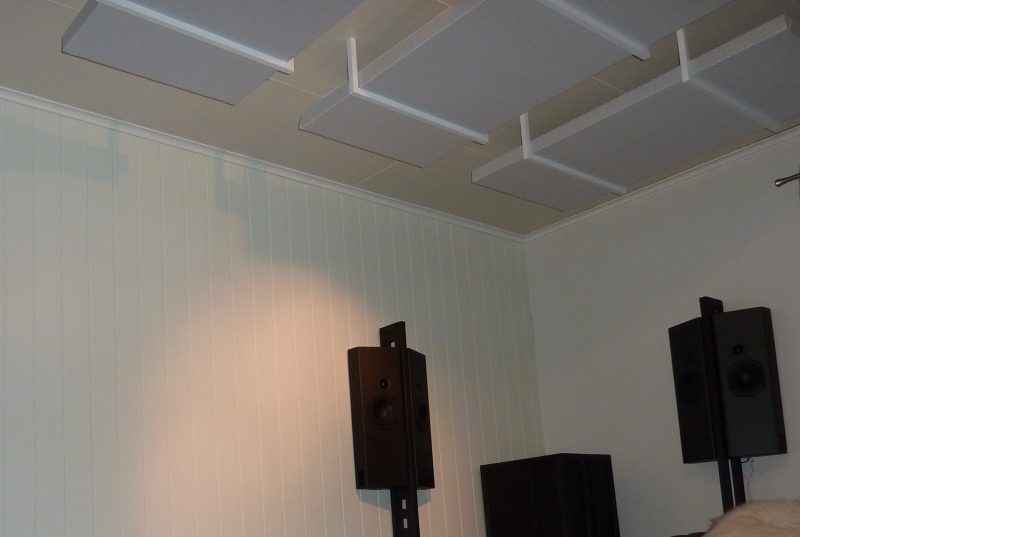
Reflections from surfaces such as walls will cause the sound to be less clear, and sometimes attain a hard character. Speech intelligibility will be compromised, and individual sound sources does not appear with the proper sense of physical dimension and lacks precise location in the sound field.
Reflecting surfaces are where you can trace a reflective path from your listening position back to a speaker, either through single reflection - typically sidewall, or multiple, such as sidewall-back-front. Sound reflects like light - entry and exit angle on reflecting surface is the same.
First reflection points are where you can see the reflection of the speaker from the listening position
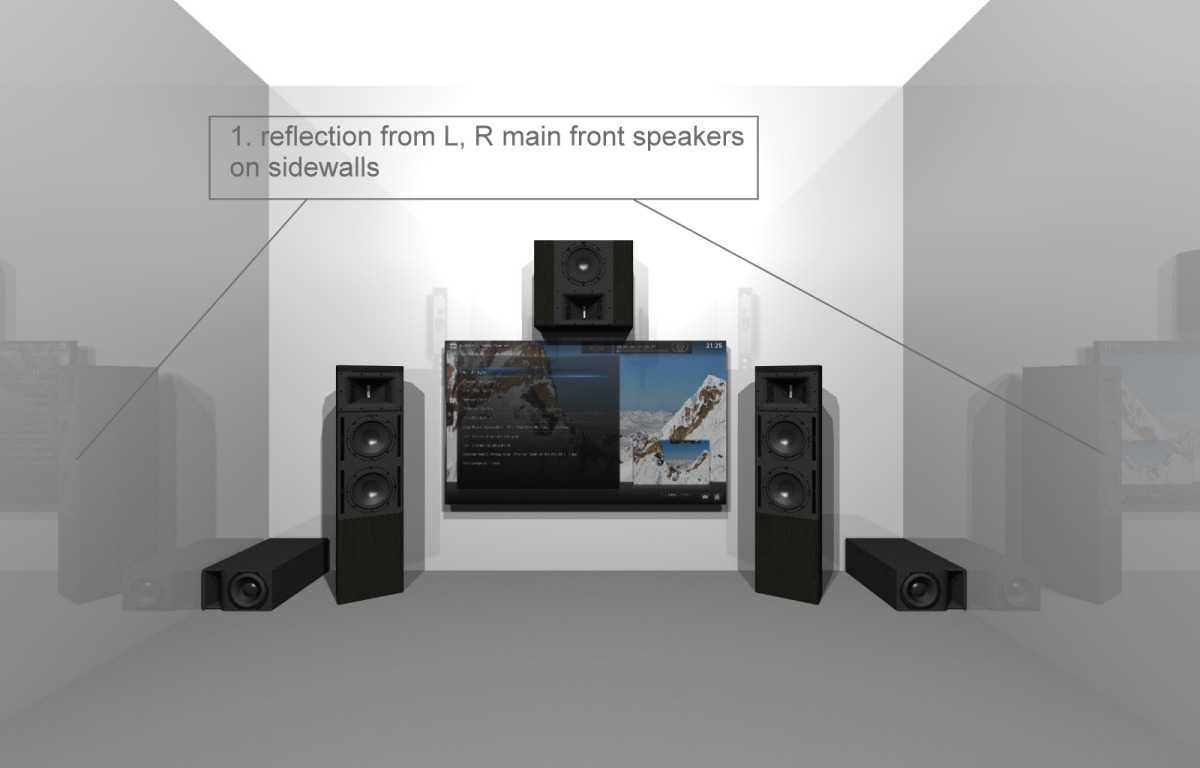
But we need to consider radiation pattern. Front left speaker, seen from listening position, radiation in blue - for high frequencies the sidewall, floor or ceiling does not exist

We turn around and see that there is a first reflection point on the back wall. From above, we see the speaker radiates high frequency sound into back wall and part of the right sidewall.

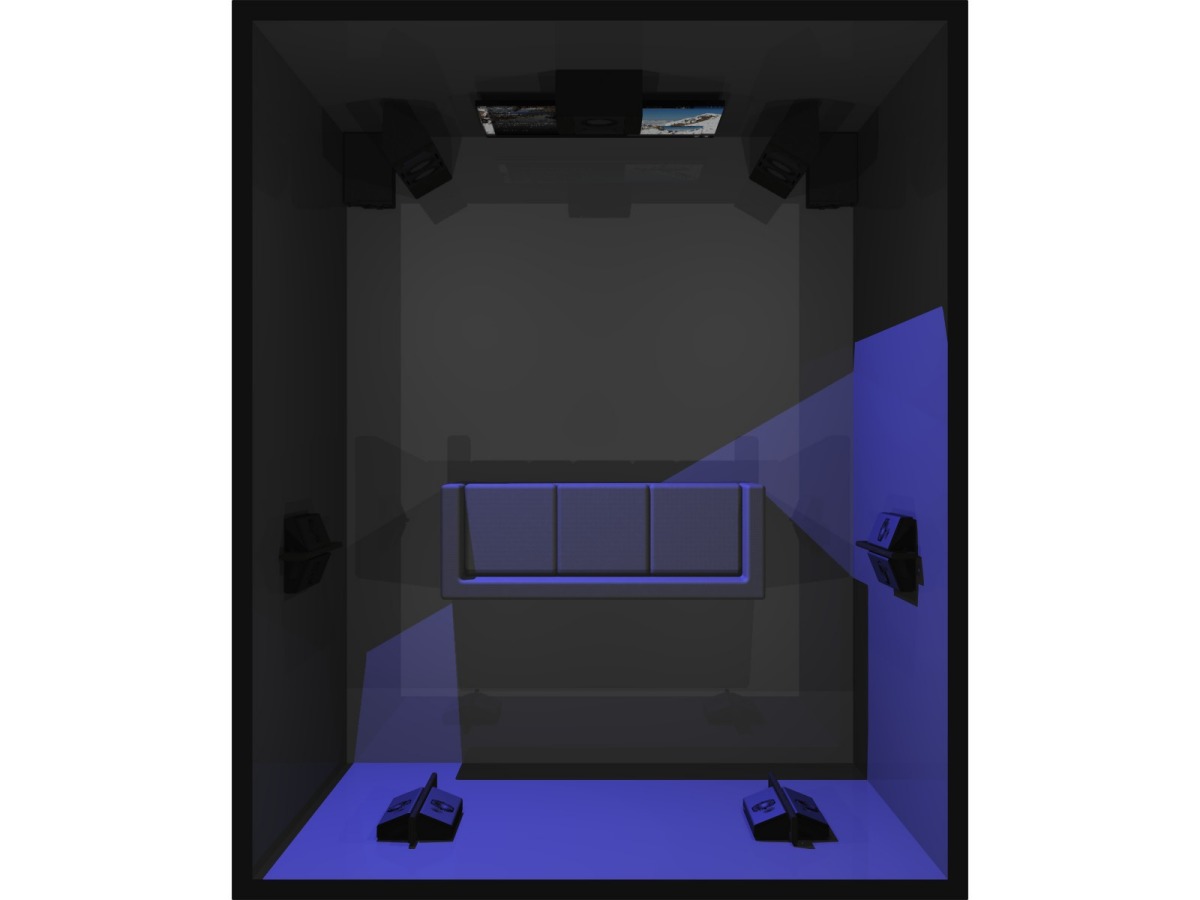
At lower frequencies the speaker becomes increasingly omnidirectional, now there are reflections on the left wall and floor for midrange frequencies.


Since you now have chosen speakers with good directivity control, it may not be necessary to do much with the side walls, but the back wall should be damped, and this is more important if the back wall is close to the listening area.
This is the reflection pattern for one speaker - left main front. All other speakers will also have reflections, but focus on the front L-C-R speakers first, and then worry about the surrounds later. This is where a surround system is very different from 2-channel stereo - there are more speakers and many more reflections.
For best surround sound all reflections from all speakers should be treated, but using absorption only will make the room too dead. The solution is to use diffusion instead - spreading the reflection back into the room in a wide angled pattern. It is also desirable to treat all reflection points similarly, to achieve a homogeneous sound field. In practical situations some compromises are inevitable, especially if the room is multi-purpose, having acoustic absorbers and diffusors covering all walls is usually not an option in a normal living room.
Direct sound and 1. reflections from walls for L, C, SR, SBR speakers
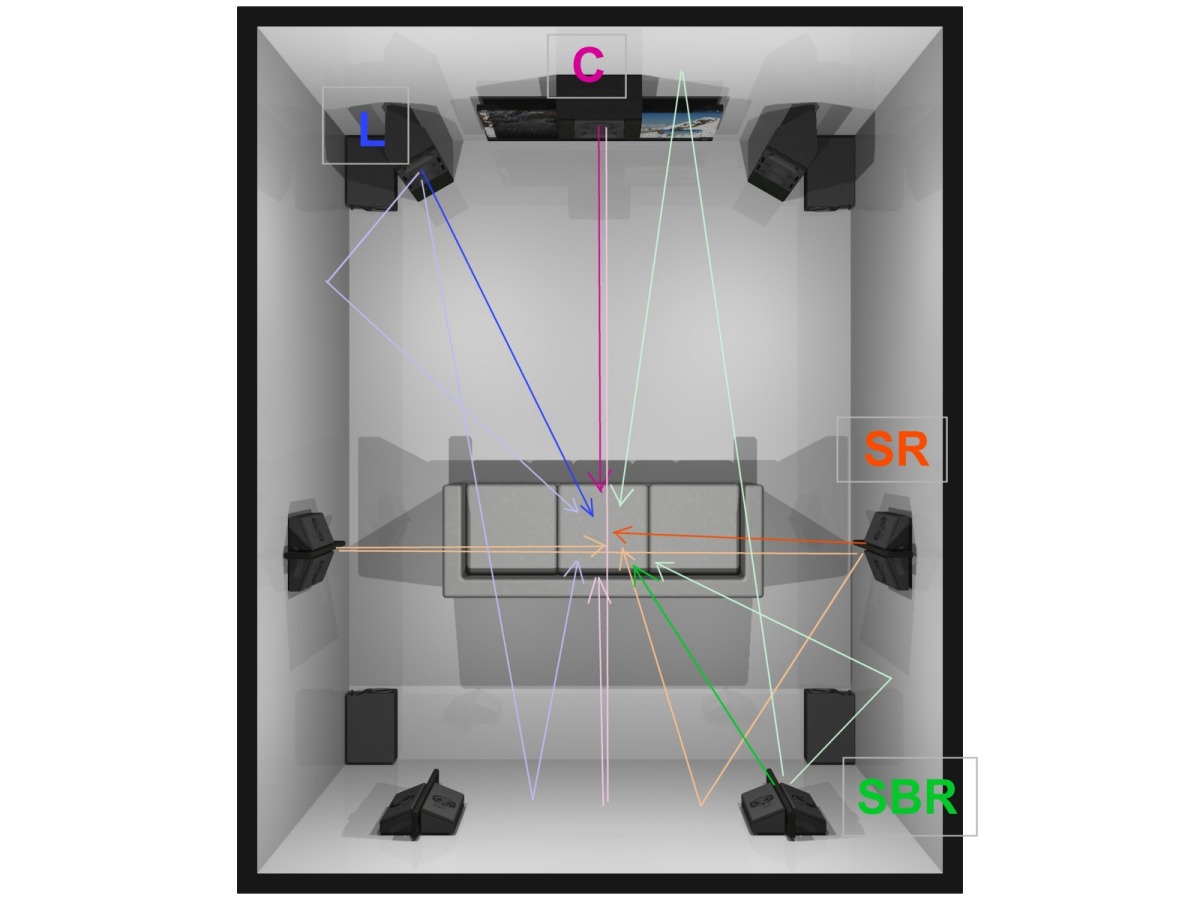
Subwoofers work at low frequencies only, they have boundary interference with all surfaces inside the room, but no reflections that can be easily removed by using a thin panel.
Acoustic panels are good for reflection control. 50mm thick panels on a reflective surface will absorb sound from midrange and up. For better, wider frequency range absorption rock-wool or fiber glass standard building insulation in 20cm thickness will work better.
Reflection points on walls and ceiling can be treated with such absorption. Thickness and size determines frequency range for which the absorption is efficient, and as we see from the speaker radiation pictures there is no point in adding thin high-frequency absorption to the sidewalls or front wall, thicker and larger is needed to work at lower frequencies.
Usually the floor reflection is left untreated, it is not practical to place acoustic damping on the floor where people are walking.
It is not desirable to remove all reflections, if you use too much damping it will sound unnatural and dull. Leave some space untreated, and consider using acoustic diffusors which spread the sound reflection evenly back in to the room.
Back wall with acoustic absorption panels and S1.2 surround loudspeakers
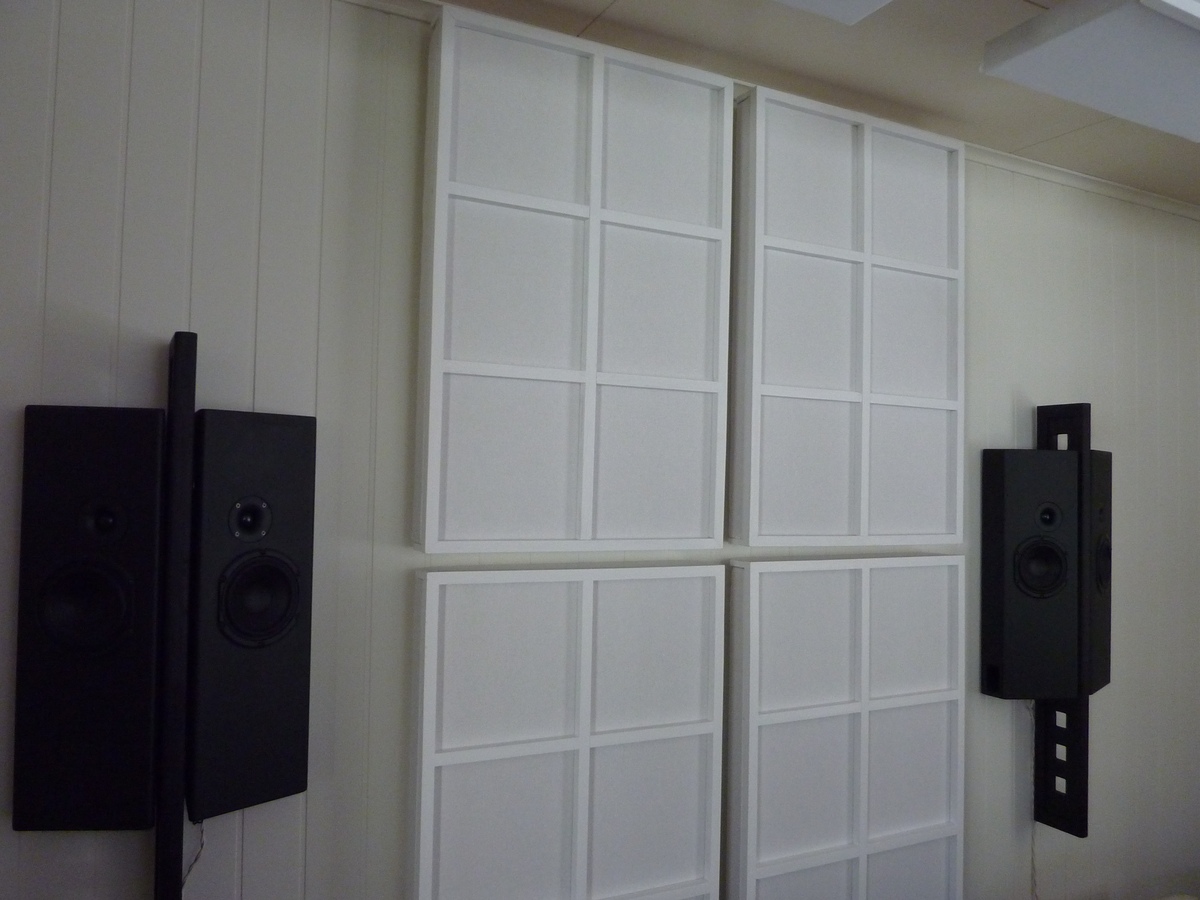
Room modes and boundary interference
At lower frequencies, typically around 200Hz and below, the response will be dominated by boundary interference - reflections from the surfaces around the speakers and reflections around the listener. Boundary interference is what causes most of the irregularities and deep cancellations on the frequency response.
Room modes can also be troublesome in many rooms - waves that resonates between the rooms acoustic boundaries - between walls, between floor and ceiling, there are also circular modes. These resonances are worse if the walls are very rigid, such as concrete walls.
At lower frequencies there are also reflections from the front wall and ceiling, wavelengths are large and we call them boundary interference

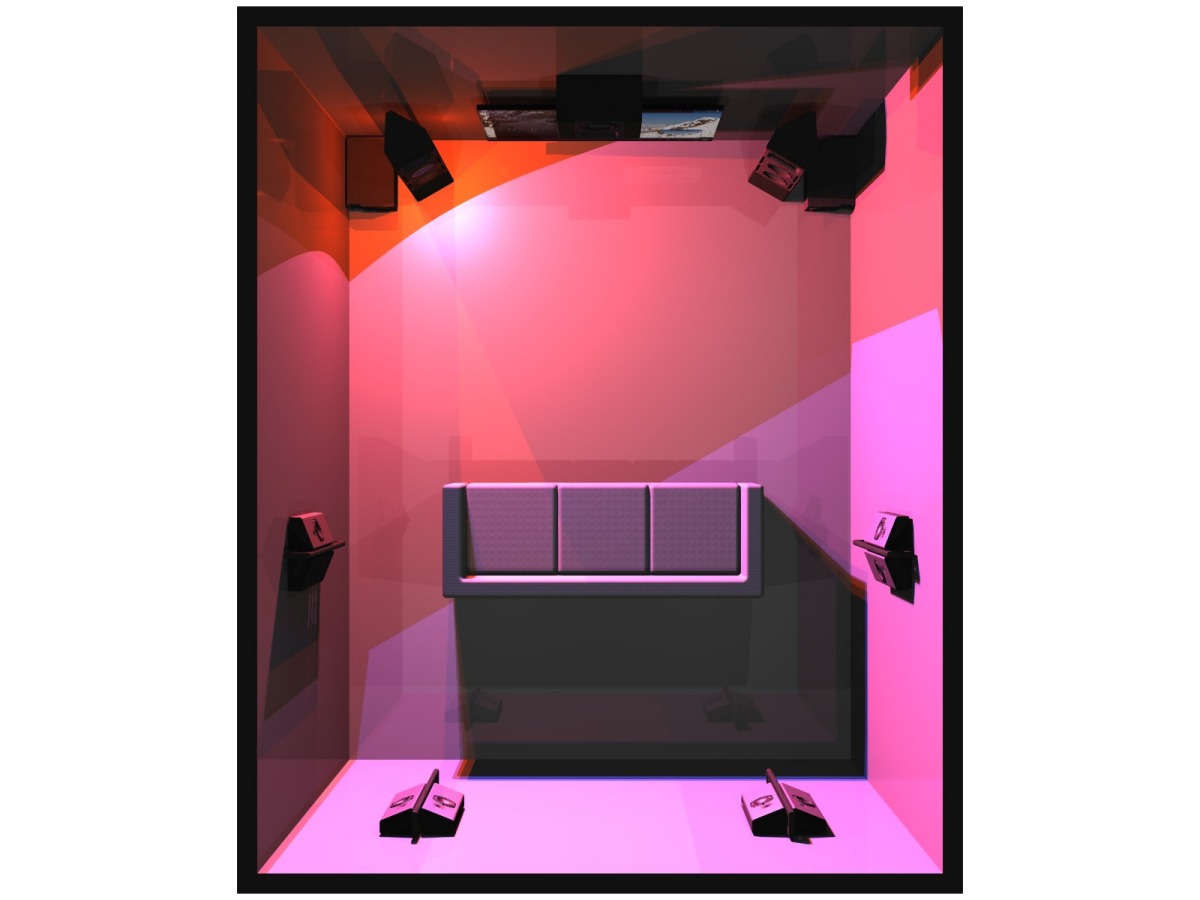
It is possible to fix this even in smaller rooms, but large constructions covering whole walls are required. This may not be practical in your room, or you simply will not put in the required effort.
A proper subwoofer system with several subwoofers will make a huge improvement in the lower bass range. Multiple sound sources will even out the response. Most subwoofers also has some kind of equalizer or digital sound processor, so that it is possible to adjust the frequency response and level out peaks.
A better solution is to have proper 40cm acoustic absorption on the back wall, and place all subwoofers on the front wall. This will solve all major bass problems if the subwoofer system is large enough to act like a large sound source from floor to ceiling.
Signal processing room correction software can reduce the effects of boundary interference close to the speaker. This is achieved using time corrective filters, and must not be confused with equalizing, which only corrects the frequency response.
How to deal with boundary interference:
- Move speakers
- Move listening position
- Use multiple subwoofers
- Use equalizer
- Large acoustic damping constructions
- Use time-domain corrective room correction
Boundary interference from front wall and back wall causes huge dips in the frequency response

In a small room the acoustic behavior changes with frequency. At low frequencies discrete boundary interference reflections causes dips and peaks affecting larger parts of the frequency curve, at high frequencies the reflections appear diffuse.
Since absorption at low frequencies requires very much damping - thick and covering whole surfaces, the result is too much high frequency damping, and the room will sound very dull. By using more diffusion at higher frequencies, it is possible to achieve a much more balanced sound. In a small room it is a good approach to try to get as much low frequency absorption as possible, and as much diffusion as possible at higher frequencies.
Acoustic behavior changes with frequency

If your seating is leather, then put some blankets over the backs and pillows on seats not in use, because the leather surface will cause early reflections due to the relatively close distance to the listeners ears.
Also, avoid seating with very high back-rests, as they will obstruct the sound from side and back channels.
Acoustic treatment inside the room has no effect on the sound level outside of the theater. To significantly reduce the sound level outside, very extensive construction work has to be done.
Some improvement can be achieved by covering walls and ceiling with an extra layer of drywall panel, but this will not enable you to watch movies at reference while others are sleeping in a nearby room.
Better speakers with controlled directivity will be less affected by room acoustic properties, and can give reasonably good results with less acoustic treatment. This makes it easier to get a nice esthetic appeal, and will also lower the total cost.
All items placed inside a room affects its acoustic properties. Sofas, chairs, bookshelves, curtains, carpets will contribute to lower the reverberation by absorption, change reflections and change boundary conditions.
A puff in front of the speaker functions as an acoustic absorber, and fits nicely in as part of the interior

Tactile response and floor construction - build a riser
At very low frequencies below 20Hz it turns out that tactile response - feeling the sound physically on your body - is greatly affected by the resonant behavior of the floor. A wooden floor will move and add physical tactile feel, while a solid concrete floor in the basement may not move at all.
Building a riser platform to place the seating on will greatly enhance this tactile motion, especially if you have that concrete floor. It does not need to be high, but the sides should be sealed so that the space between the floor and riser platform forms an airtight volume, and it must be able to flex or rest on some kind of flexible suspension like rubber feet to allow movement.
A reason for turning up the volume louder once you reach a level where dialogue and details can be easily heard is the tactile feel of the sound acting on your body - this sense of powerful sound.
Tactile feel is determined by sound field properties - not only sound pressure, but also particle velocity and sound intensity.
Tactile properties affects how the bass is perceived, a system with proper tactile response will also sound better at reasonable listening levels.
The sound source affects tactile feel - a larger source is better. This is one of the reasons you can experience nice punch on a live concert - the loudspeaker system is physically large. Horns tend to have better tactile feel than small sealed subwoofers.
Room boundary reflections destroy tactile feel, this is the other reason you experience much better punch in the bass at an outdoor live concert - there are no significant reflections at low frequencies.
To preserve as much tactile feel as possible in a small room it is necessary to consider both the sound source and acoustics. Larger subwoofers systems and good acoustic damping works better. When setting up a multiple subwoofer system it is important to account for sound field properties, in a bad case it is possible to end up removing all tactile feel if you use only sound pressure measurement for adjustments.
Acoustics plan for home theater in the living room
- Suspended acoustic ceiling panels or ceiling absorber cloud - or:
- Replace the ordinary ceiling with acoustic ceiling panels
- Consider acoustic panels on side walls if reasonable due to interior design considerations
- Acoustic panels on most of the back wall surface
- Multiple subwoofers properly set up with DSP to deal with low bass resonances and modes
- Consider acoustic properties when choosing seating - no high backs, leather must be covered with blankets
- Dining table? Consider decorative objects placed on the table to break up and absorb the reflection from the center channel
Acoustic treatment without doing extensive construction work
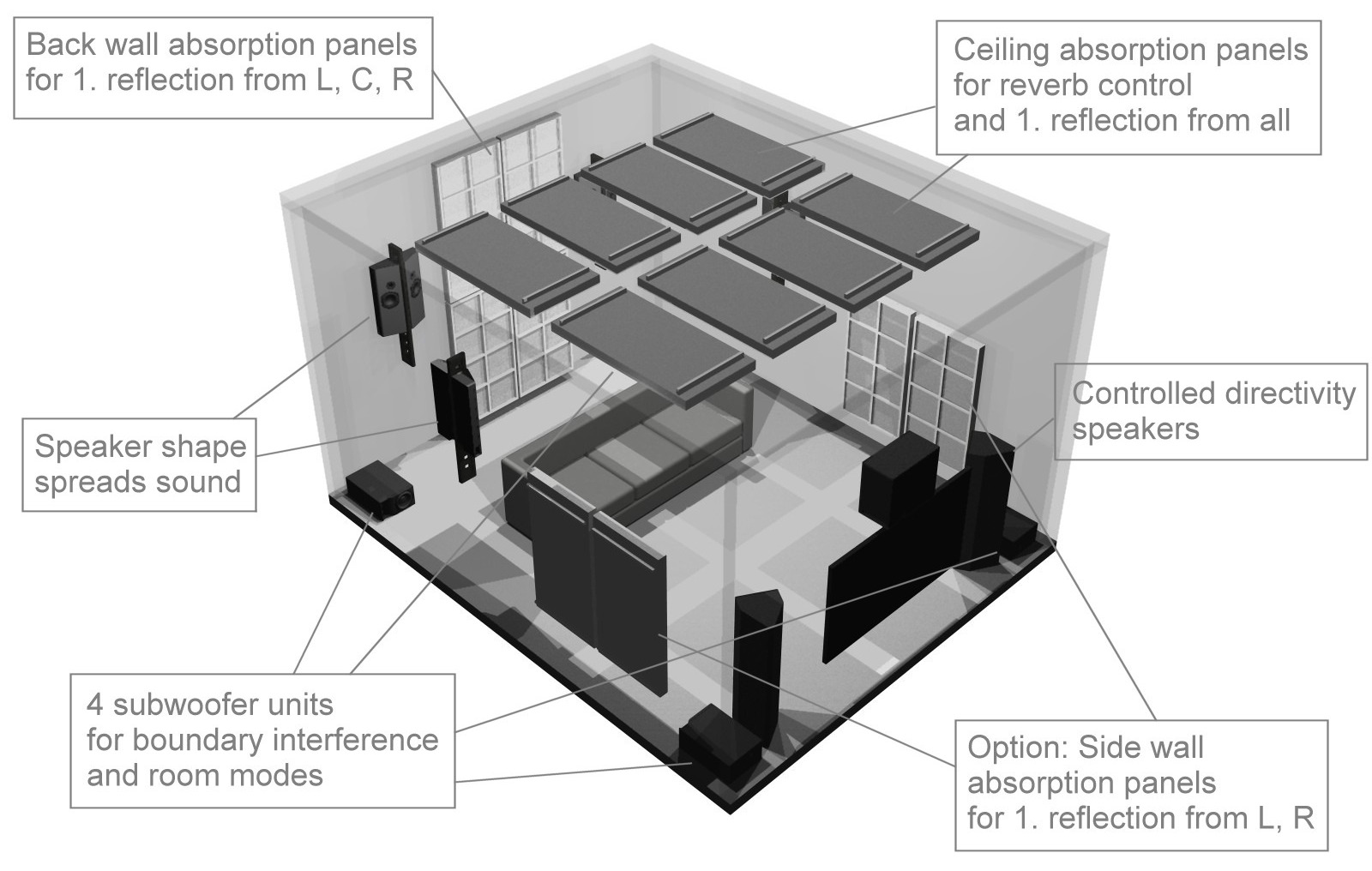
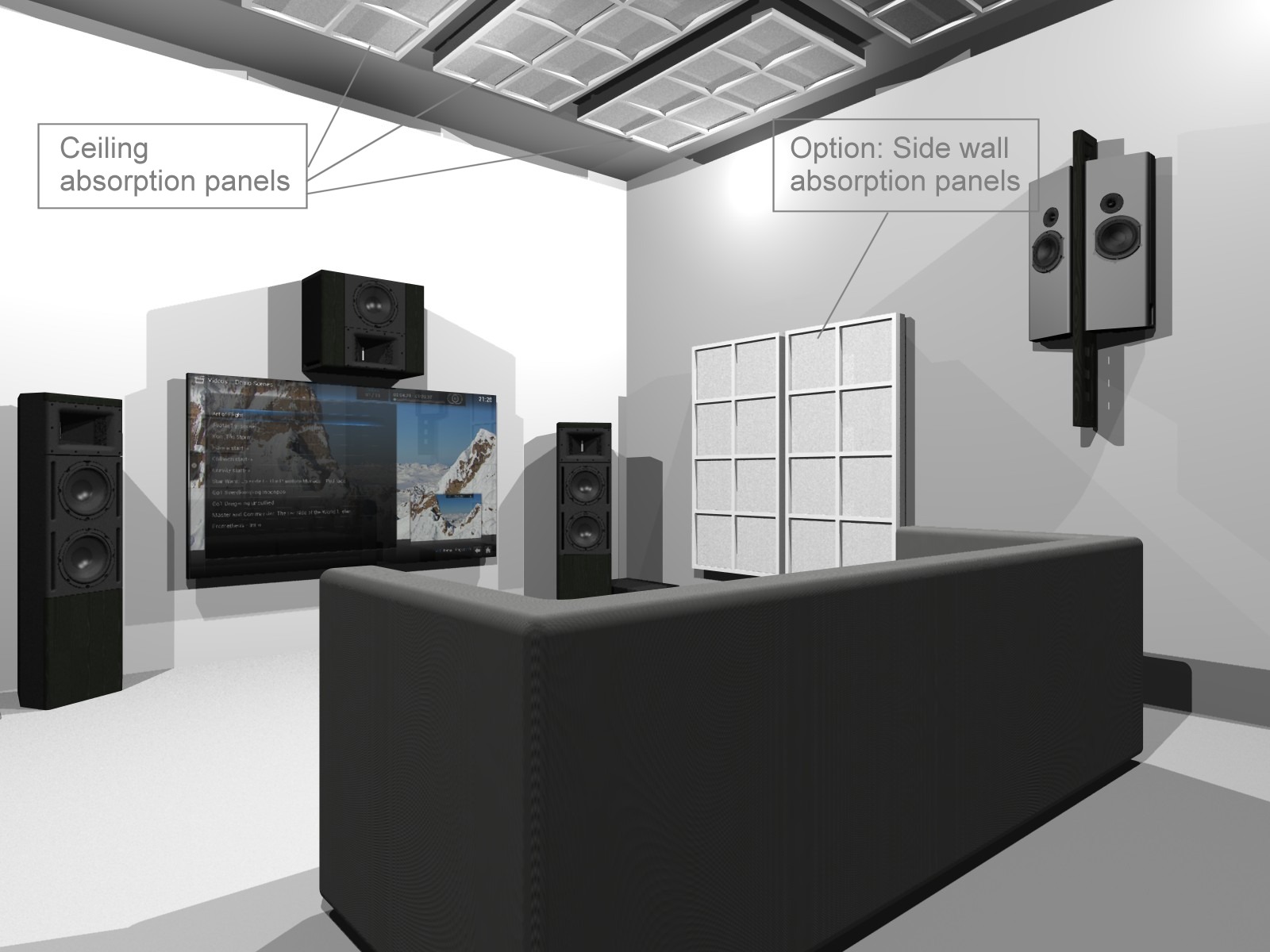
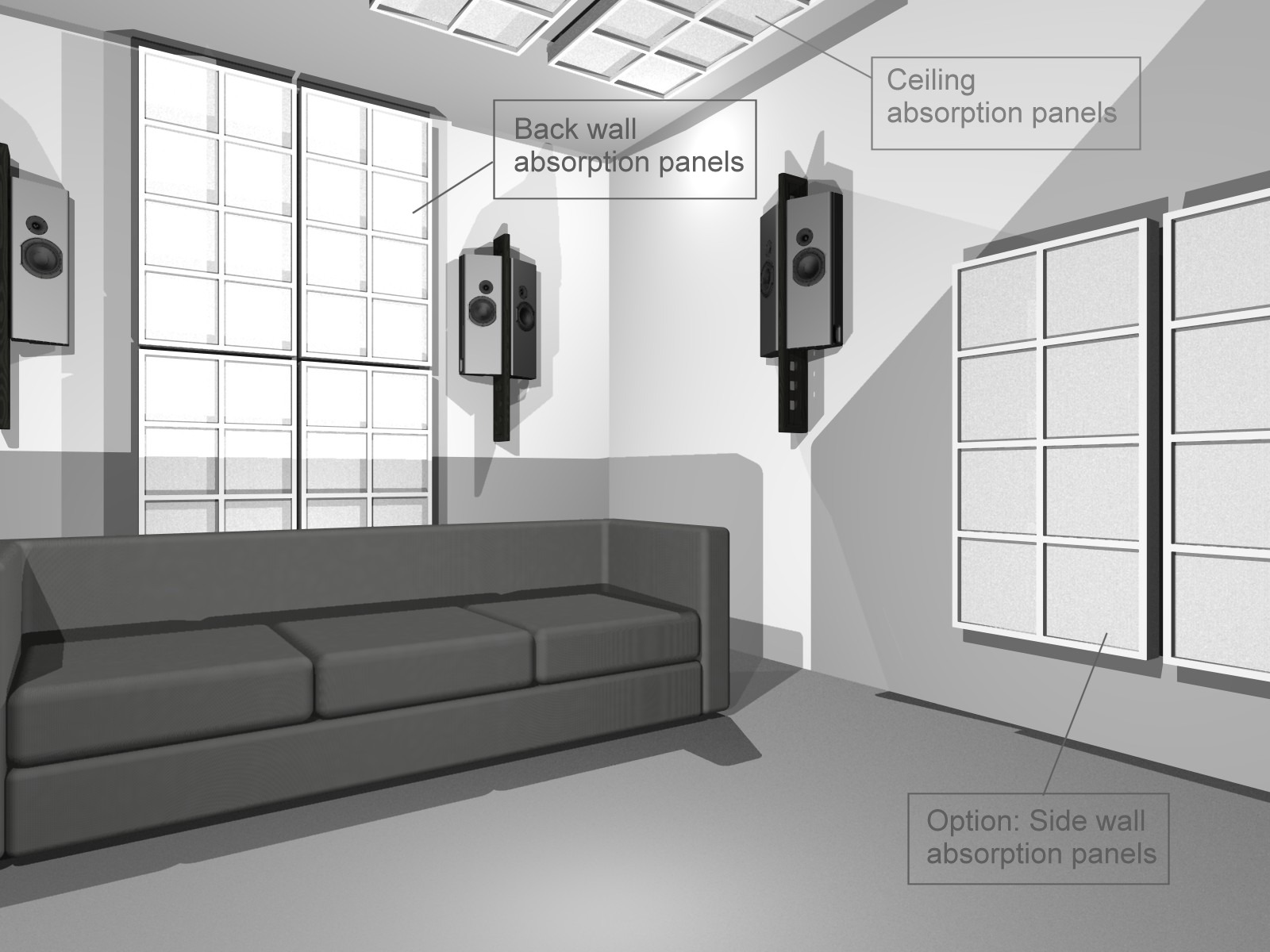
Acoustics plan for dedicated home theater / media room
- 20cm damping with slats on ceiling
- 40cm damping with slats on back wall
- 20cm damping with slats on front wall
- Subwoofer system on front wall, large to create plane wave
- Consider 20cm damping with slats on side walls
- Consider acoustic diffusors for more and proper diffusion
- Consider acoustic properties when choosing seating - no high backs, leather must be covered with blankets
- Build a riser
Building a room from scratch - use the opportunity to fix acoustics properly
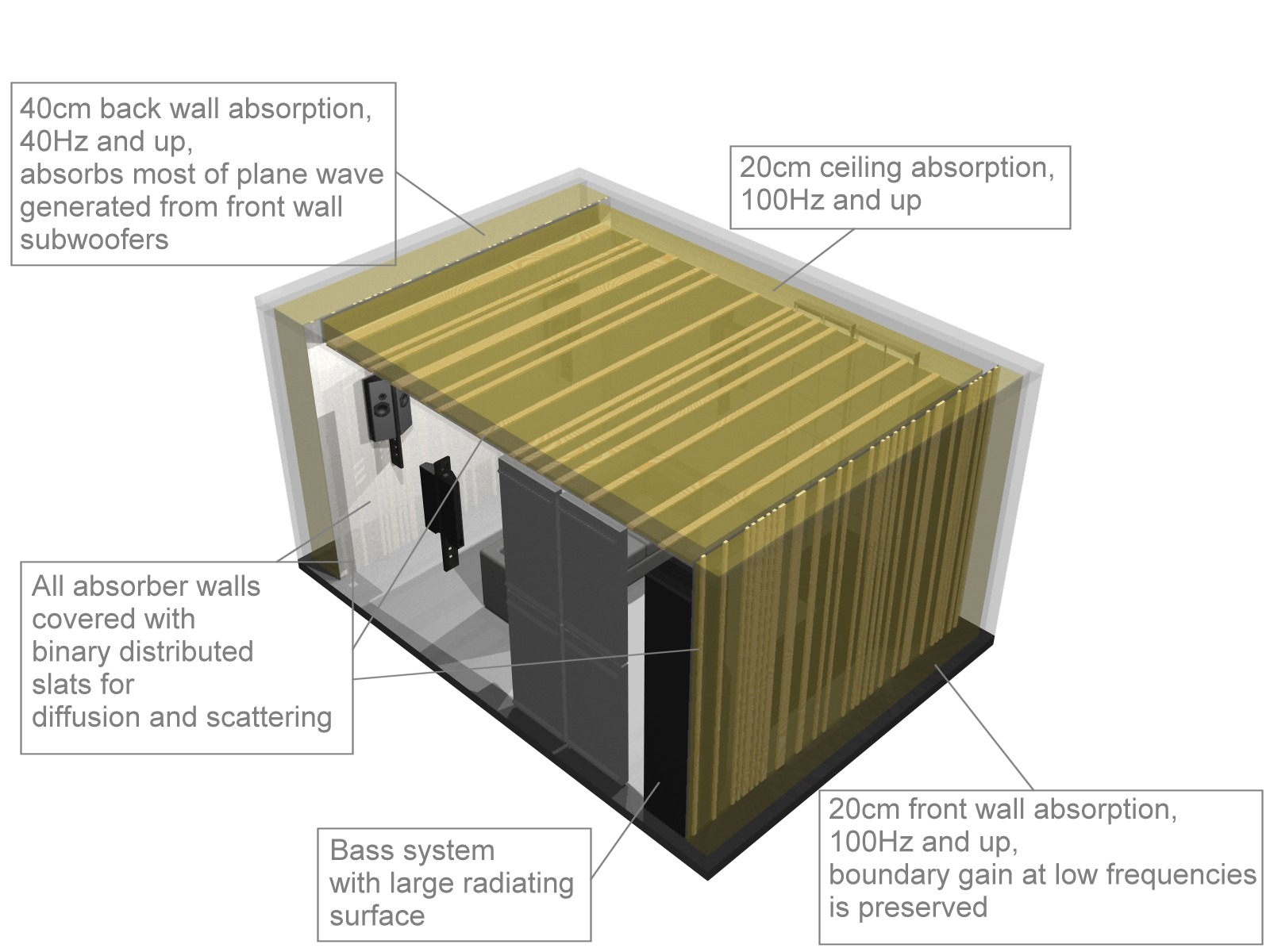
Acoustic treatment built into the wall - absorption at low frequencies, diffusion and scattering at high frequencies







